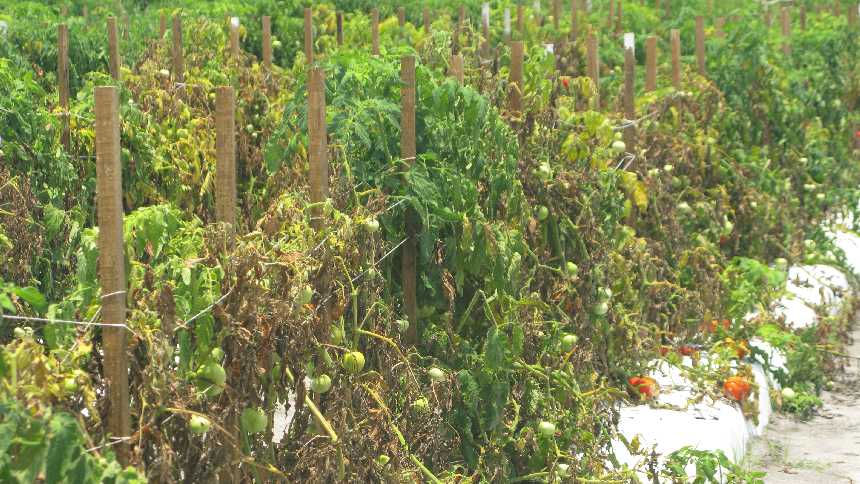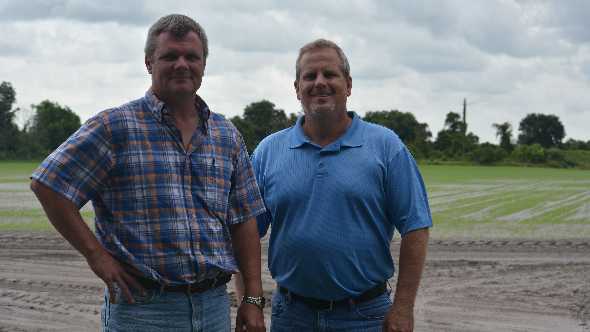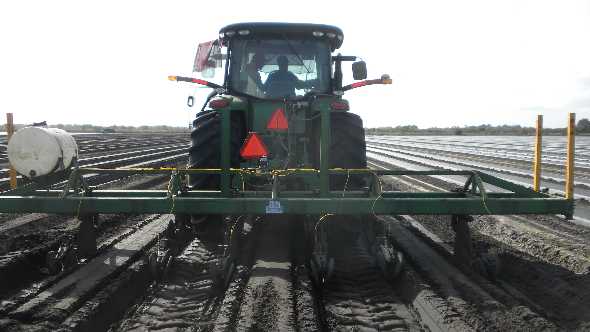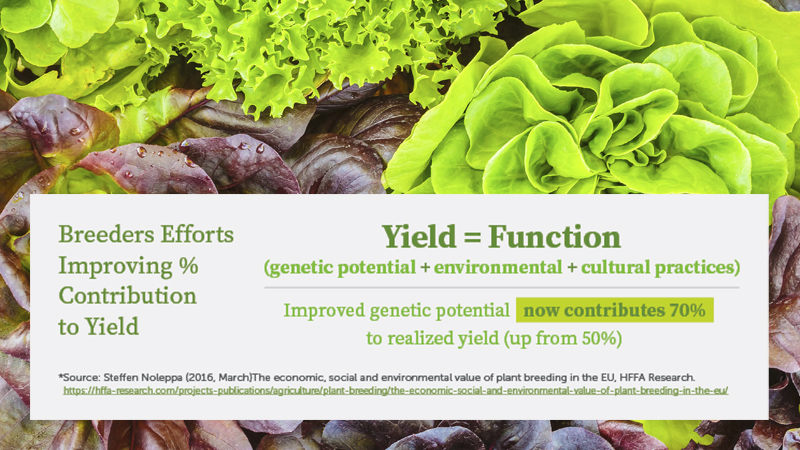Growers, Scientists Setting Sights On Soilborne Disease

Fusarium wilt has been one of the bigger disease challenges for growers in the absence of methyl bromide.
Photo courtesy of UF/IFAS
So, just how bad have soilborne diseases gotten in some fields since the phase-out of methyl bromide? Really bad.
“We’ve seen a dramatic increase in diseases caused by soilborne pathogens on several vegetable crops,” says Gary Vallad, a UF/IFAS plant pathologist. “In particular, we’ve seen an increase in root and vascular wilt diseases caused by pathogenic Fusarium species, such as Fusarium wilt and Fusarium crown rot and root rot of tomato; and Fusarium wilt of watermelon and cantaloupe. We’ve also seen increases in southern blight, caused by Sclerotium rolfsii, across numerous vegetable crops.”
According to Vallad, growers typically don’t give disease issues much thought until incidence in a field exceeds 5% consistently. For Fusarium wilt, Fusarium crown rot, and root rot, fields with disease incidence of 20% to 30% are common these days.
“I’ve seen some fields with disease incidence well over 50%,” he adds. “The disease level in a given field can fluctuate from year to year for various reasons.”
For southern blight, incidence has ranged from 1% to 20%. The occurrence is often more sporadic due to the environmental conditions required (high heat, high humidity, and water-saturated soils) for disease development. However, if conditions are conducive, the disease develops rapidly and at any stage of plant growth.
Scott DiMare, vice president for DiMare Fresh, says the increasing pest pressure is affecting the longevity of the crop.

Gary Vallad (left) and Scott DiMare
Photo by Frank Giles
“There is no doubt every year we are seeing more pressures from weeds and diseases,” DiMare says. “The tomato crop is just not holding up. Once they start to stress with load, they start going backwards. When you start picking, they go back even further. We have lost about two weeks to a month off the tail end of the crop. In the spring crop, that might be the difference between picking two times or three times. And, a lot of times, that third picking is where your profit is made.”
With every season further removed from methyl bromide, DiMare says the pressures can be a little more extreme. Fusarium is the biggest challenge on the farm. What was a small percentage on the farm four years ago has grown. Small parts of fields have become bigger parts of fields and fields that never had issues before do now.
“Obviously, we are using good agriculture practices and how we manage our equipment, but inevitably when you are a commercial-size farm, it is very hard to keep everything sterilized from field to field,” DiMare says. “The disease has been spreading into places where we have not seen it.”
“That is the thing with soilborne diseases and nematodes,” Vallad adds. “It takes time for them to develop and spread. Weeds were different. They were very noticeable right away after methyl bromide. But, these diseases take more time and you combine it with the fact that some seasons are very conducive for disease development and other seasons are not, it can take time be aware there is a problem.”
And once a disease pathogen is in the soil in a field, it is never going to be eradicated from the system. Vallad says researchers and growers will have to develop ways to manage around these challenges.
Explosion Vs. Trickle
Vallad describes the fumigation of a bed with methyl bromide as an “explosion” moving through all parts the bed eliminating disease pathogen, nematodes, and weed seeds along the way. The current alternatives to methyl bromide act more like a liquid rather than a fumigant. He adds that the alternatives will do a decent job if the product comes in contact with the pests.
“That’s what we noticed with the weeds first,” he says. “We saw the nutsedge popping up on the edges of the beds. That told us we were not getting coverage throughout the bed.
“We are killing the pathogen when you put the fumigants out, so we are trying to expand the fumigated zones in the beds. So, we are working with ways to expand the zones to buy a little extra time. To get that extra two weeks and four weeks, Scott mentions on the tail end of the season.”
DiMare says the biggest challenges have been the spring tomato crop because of the weather and soil temperatures. Beds are being laid in colder conditions, which is a big part of the problem. In the fall, even though it is wetter, the temperatures are warmer, so challenges have been less with those crops.
DiMare adds that the learning curve of managing soilborne diseases is an ongoing process.
“The problem is methyl bromide is gone forever and it was idiot proof,” he says. “You put it out there, it did its thing, and boom — it was gone. Going forward, we are going to have to be far more specialized in dealing with specific challenges in individual fields.”
Vallad says he and fellow researchers are hoping to develop a decision matrix that will allow growers to be more specific in their application decisions based upon the particular pest and disease challenges in a field.
“We need a recipe for a field, depending whether you have Fusarium here or a nematode problem there, if you have heavy or light soil, weather conditions, and time of year,” DiMare says. “Ultimately, we are going to need to build resistance into these varieties because there are just too many variables between weather, soil types, and how these fumigants are reacting when applied.”
Get To The Edge
One tactic Vallad has been studying is a secondary application of fumigant along the side of the beds. Right after the beds are pulled, a Yetter coulter is used to apply chlorpicrin right under the tuck of plastic in the bed.

Trials currently are evaluating the use of a Yetter rig to apply fumigant to the sides of the bed.
Photo courtesy of UF/IFAS
“We looked at root mass and pulled samples from the edge of the bed, and it made a huge difference how much roots were growing in this area of the bed,” Vallad says. “I think this accounted for the huge improvement in plant vigor where we did the side application test.
“It is interesting where we did this trial, we didn’t have a lot of disease pressure, but yet we saw a big improvement in yield. So, even with low disease pressure, we are seeing a benefit in improved plant vigor. And you might have other weaker, opportunistic pathogens there in the bed nibbling at the roots, which this side application is picking up.”
Vallad says researchers are looking into modifying the bed structure to better distribute fumigants, but it appears alternative application methods will be the best approach toward improved disease control.
“We were looking at narrower beds, but when you start messing around with the beds, you start impacting your irrigation and fertility,” Vallad says. “We talk about this with some growers and it was not ‘no,’ but ‘hell no.’ Modifying equipment is cheaper and easier, so it’s what we are looking at now with the application to the sides of the beds.”
“We are looking to develop alternate delivery methods with these products,” DiMare says. “We have changed the knives on our fumigation rigs with different orifices to break up the concentration. We are putting out the same amount of product, but applied over six ports as opposed to three ports. I am not saying that is the right way. We are still figuring that out.”
DiMare adds some growers have experimented with knives that spread through the bed (bat wings), but it can lead to bed integrity problems.
Work In Progress
Vallad and DiMare have been working together on alternative approaches to manage soilborne diseases for about five years.
“Basically, research-wise, everybody wanted a plug-and-play replacement for methyl bromide,” Vallad says. “We kind of wore that out because the reality is there will never be another product like methyl bromide, and if there ever was, EPA would never label it.
“Everything we are doing right now is still proof of concept. I am confident we’ll fabricate a better way of managing these soilborne diseases. I have learned never to underestimate the ingenuity of American farmers like Scott and others.”










